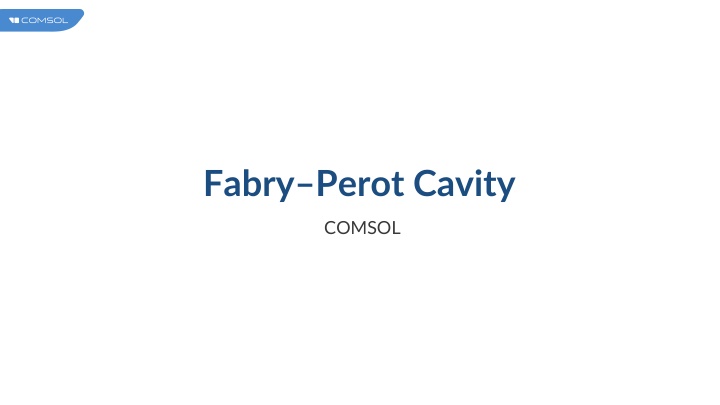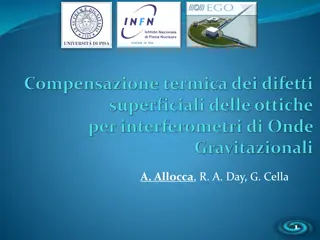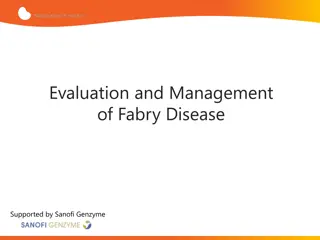
Fabry-Perot Cavity Simulation for Resonance Frequencies and Q-Factors
Explore a COMSOL simulation model of a Fabry-Perot cavity to determine resonance frequencies and Q-factors. Learn about the geometry, materials, and boundary conditions involved in this electromagnetic wave study for optical applications.
Download Presentation

Please find below an Image/Link to download the presentation.
The content on the website is provided AS IS for your information and personal use only. It may not be sold, licensed, or shared on other websites without obtaining consent from the author. If you encounter any issues during the download, it is possible that the publisher has removed the file from their server.
You are allowed to download the files provided on this website for personal or commercial use, subject to the condition that they are used lawfully. All files are the property of their respective owners.
The content on the website is provided AS IS for your information and personal use only. It may not be sold, licensed, or shared on other websites without obtaining consent from the author.
E N D
Presentation Transcript
FabryPerot Cavity COMSOL
Introduction A Fabry Perot cavity is a slab of material of higher refractive index than its surroundings. Such a structure has certain resonance frequencies. Although the solutions can be found analytically, this model demonstrates how to find the resonance frequencies and the Q- factors using a COMSOL Multiphysics simulation. A Fabry-Perot cavity. An electromagnetic wave, traveling at normal incidence, is partially reflected and transmitted at each interface between different dielectrics. When the round trip, 2L, is an integer number of wavelengths, this cavity is resonant.
Model Definition The geometry consists of three types of domains a central domain of unit width with a refractive index of 4 air domains on both sides of the central domain two outer Perfectly-matched-layer (PML) domains The wave is propagating in the x direction with out-of-plane polarization. Model geometry.
Model Definition All domains, except for the center domain, have a refracive index of 1. Air domains.
Model Definition The spacer layer has a refractive index of 4. Spacer layer.
Model Definition The PMLs absorb without reflection any incoming evanescent or propagating wave. The PMLs are backed by Scattering boundary conditions (SBCs), to further reduce the reflections. The Perfectly matched layers (PMLs).
Model Definition The boundary condition on the top and bottom edges is Perfect magnetic conductor (PMC), which implies that the solution is mirror symmetric about those planes. Perfect Magnetic Conductor 1
Eigenfrequency Study Solve the model as an eigenvalue problem. Specify the number of eigenfrequencies to solve for. Specify the frequency around which to search. The eigenfrequency approach has several drawbacks: The results must be manually examined to identify any spurious, nonphysical, modes. It requires solving a nonlinear eigenvalue problem using a memory-intensive direct solver. Could be a concern for 3D models, where many mesh elements are required.
Frequency Domain Study Recast the problem as a frequency- domain model and excite the structure over a range of frequencies. The excitation should be as isotropic as possible, so that it can excite all possible modes. The present example uses a line current condition applied to a point. The model is run in the frequency domain over a range covering the expected resonance frequencies. Line Current (Out-of-Plane) 1
Results The settings for the eigenfrequency solver have been adjusted to only return physical modes. However, sometimes also nonphysical modes can be returned. Those modes represent solutions to the numerical eigenvalue problem that have no physically meaningful interpretation. Nonphysical eigenmodes can be identified in two ways: Visually inspect the field solutions, noticing that some modes exist purely in the PML regions. Examine the Q-factor for each mode. A nonphysical mode has a Q-factor less than 1/2. The results of the eigenvalue analysis.
Results The total energy density is computed inside the cavity region. Peaks correspond to the resonant frequencies, f0, and the Q-factor can be computed as Q = f0/ f, where f is the full width at half maximum. This is an alternative approach to finding the resonant frequencies and Q-factors that requires less memory than running the eigenfrequency analysis. Avoids the problem of finding and eliminating spurious modes. Requires that the desired modes are indeed excited. Evaluation of the Q-factor requires manual postprocessing of the data. Energy density in the cavity for a range of frequencies.
Results The E-field norm at 37.5 MHz.







